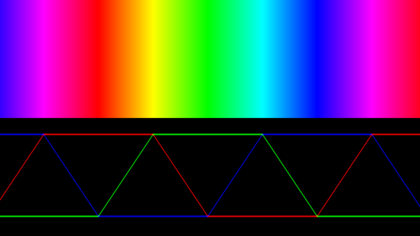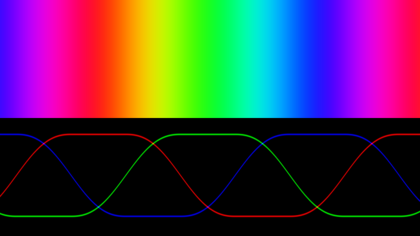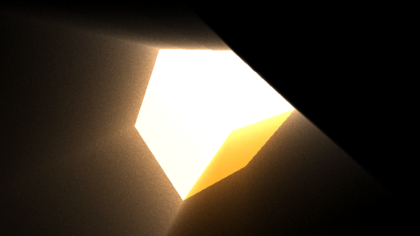GLSL snippets: Difference between revisions
Jump to navigation
Jump to search
Content added Content deleted
(dithering) |
(→Colours: blue ice gradient) |
||
| (12 intermediate revisions by the same user not shown) | |||
| Line 16: | Line 16: | ||
} |
} |
||
</source> |
</source> |
||
The point here is to convert the length returned by the distance function into a number of pixels, and then we can smooth the outline over the precise number of pixels that we want (here 1.5). |
|||
== Ray marching == |
== Ray marching == |
||
| Line 22: | Line 24: | ||
// http://jamie-wong.com/2016/07/15/ray-marching-signed-distance-functions/ |
// http://jamie-wong.com/2016/07/15/ray-marching-signed-distance-functions/ |
||
vec3 rayDirection(float fieldOfView, vec2 size, vec2 fragCoord) { |
vec3 rayDirection(float fieldOfView, vec2 size, vec2 fragCoord) { |
||
vec2 xy = fragCoord - size / 2. |
vec2 xy = fragCoord - size / 2.; |
||
float z = size.y / tan(radians(fieldOfView) / 2. |
float z = size.y / tan(radians(fieldOfView) / 2.) / 2.; |
||
return normalize(vec3(xy, -z)); |
return normalize(vec3(xy, -z)); |
||
} |
} |
||
</source> |
</source> |
||
Note: The original <tt>rayDirection()</tt> is missing the divide by 2 when calculating z. This causes the field of view parameter to be incorrect. |
|||
<source lang="GLSL"> |
<source lang="GLSL"> |
||
| Line 108: | Line 112: | ||
=== HSV === |
=== HSV === |
||
==== Plain HSV ==== |
|||
[[File:hsv2rgb.png|420px|thumb|<tt>hsv2rgb()</tt>]] |
|||
<source lang="GLSL"> |
<source lang="GLSL"> |
||
| Line 117: | Line 125: | ||
} |
} |
||
</source> |
</source> |
||
==== Smooth variant ==== |
|||
[[File:hsv2rgb2.png|420px|thumb|<tt>hsv2rgb2()</tt>]] |
|||
<source lang="GLSL"> |
<source lang="GLSL"> |
||
// https://www.shadertoy.com/view/wlsSRB |
// https://www.shadertoy.com/view/wlsSRB |
||
vec3 hsv2rgb2(vec3 c, float k) { |
vec3 hsv2rgb2(vec3 c, float k) { |
||
vec4 K = vec4(3. / 3., 2. / 3., 1. / 3., 3.); |
|||
vec3 p = smoothstep(0. + k, 1. - k, |
|||
.5 + .5 * cos((c.xxx + K.xyz) * radians(360.))); |
|||
return c.z * mix(K.xxx, p, c.y); |
|||
} |
} |
||
</source> |
</source> |
||
A good value for <code>k</code> is e.g. 0.07. |
|||
=== Gamma === |
=== Gamma === |
||
{{Main|Gamma}} |
|||
<source lang="GLSL"> |
<source lang="GLSL"> |
||
const float gamma = 2.2; |
const float gamma = 2.2; |
||
// convert from sRGB to RGB |
|||
vec3 col = |
vec3 col = pow(col, vec3(gamma)); |
||
// blending, etc. |
// blending, etc. |
||
// gamma correction |
// gamma correction (RGB to sRGB) |
||
col = pow(col, vec3(1. / gamma)); |
col = pow(col, vec3(1. / gamma)); |
||
</source> |
|||
=== Ice gradient === |
|||
[[File:ice_gradient.png|420px|thumb|Blue ice gradient]] |
|||
<source lang="GLSL"> |
|||
vec3 col = smoothstep(vec3(.2, .1, .0), vec3(1.2, 1.1, 1.0), vec3(x)); |
|||
</source> |
</source> |
||
| Line 169: | Line 196: | ||
</source> |
</source> |
||
== Post-processing effects == |
|||
[[Category:Programming]] |
|||
=== Volumetric light scattering (God rays) === |
|||
[[File:godrays.png|420px|thumb|Example of volumetric light scattering post-processing effect (with dithering).]] |
|||
<source lang="GLSL"> |
|||
// https://developer.nvidia.com/gpugems/gpugems3/part-ii-light-and-shadows/chapter-13-volumetric-light-scattering-post-process |
|||
vec3 godrays(in vec2 ScreenLightPos, in vec2 fragCoord, out vec4 fragColor) |
|||
{ |
|||
const int NUM_SAMPLES = 16; |
|||
const float Density = .7; |
|||
const float Weight = .3; |
|||
const float Decay = .88; |
|||
const float Exposure = .4; |
|||
vec2 texCoord = fragCoord / iResolution.xy; |
|||
vec2 deltaTexCoord = (texCoord - ScreenLightPos.xy); |
|||
deltaTexCoord *= 1.0f / float(NUM_SAMPLES) * Density; |
|||
vec3 color = texture(iChannel0, texCoord).rgb; |
|||
float illuminationDecay = 1.0f; |
|||
for (int i = 0; i < NUM_SAMPLES; i++) { |
|||
texCoord -= deltaTexCoord; |
|||
float dither = rand(fragCoord + vec2(200. * float(i), 23. * float(i))); |
|||
vec3 sample_ = texture(iChannel0, texCoord + deltaTexCoord * dither).rgb; |
|||
sample_ *= illuminationDecay * Weight; |
|||
color += sample_; |
|||
illuminationDecay *= Decay; |
|||
} |
|||
return color * Exposure; |
|||
} |
|||
</source> |
|||
Dithering suggested by Jessica Mak. |
|||
[[Category:Graphics programming]] |
|||
Latest revision as of 09:03, 9 April 2024
Signed distance functions
Antialiasing
const float scale = 100.;
void mainImage( out vec4 fragColor, in vec2 fragCoord )
{
vec2 uv = scale * (fragCoord - .5 * iResolution.xy) / iResolution.y;
float d = sd...(uv);
vec3 col = vec3(1) * smoothstep(-0., 1.5 * scale / iResolution.y, d);
fragColor = vec4(col, 1.);
}
The point here is to convert the length returned by the distance function into a number of pixels, and then we can smooth the outline over the precise number of pixels that we want (here 1.5).
Ray marching
// http://jamie-wong.com/2016/07/15/ray-marching-signed-distance-functions/
vec3 rayDirection(float fieldOfView, vec2 size, vec2 fragCoord) {
vec2 xy = fragCoord - size / 2.;
float z = size.y / tan(radians(fieldOfView) / 2.) / 2.;
return normalize(vec3(xy, -z));
}
Note: The original rayDirection() is missing the divide by 2 when calculating z. This causes the field of view parameter to be incorrect.
// http://jamie-wong.com/2016/07/15/ray-marching-signed-distance-functions/
float castRay(const int scene, vec3 eye, vec3 dir,
float start, float end, float epsilon, int max_marching_steps,
out int material)
{
float depth = start;
for (int i = 0; i < max_marching_steps; i++) {
float d = sceneSDF(scene, eye + depth * dir, material);
if (d < epsilon)
return depth;
depth += d;
if (depth >= end)
break;
}
return end;
}
// http://iquilezles.org/www/articles/normalsSDF/normalsSDF.htm
vec3 estimateNormal( const int scene, const float epsilon, in vec3 p )
{
int m;
const vec2 k = vec2(1,-1);
return normalize( k.xyy*sceneSDF( scene, p + k.xyy*epsilon, m ) +
k.yyx*sceneSDF( scene, p + k.yyx*epsilon, m ) +
k.yxy*sceneSDF( scene, p + k.yxy*epsilon, m ) +
k.xxx*sceneSDF( scene, p + k.xxx*epsilon, m ) );
}
Matrix transformations
// https://www.khronos.org/registry/OpenGL-Refpages/gl2.1/xhtml/glRotate.xml
mat4 rotate(float a, vec3 v)
{
float c = cos(a);
vec3 ci = (1. - c) * v;
vec3 s = sin(a) * v;
return mat4(
ci.x * v.x + c, ci.x * v.y + s.z, ci.x * v.z - s.y, 0,
ci.y * v.x - s.z, ci.y * v.y + c, ci.y * v.z + s.x, 0,
ci.z * v.x + s.y, ci.z * v.y - s.x, ci.z * v.z + c, 0,
0, 0, 0, 1
);
}
// https://www.khronos.org/registry/OpenGL-Refpages/gl2.1/xhtml/glTranslate.xml
mat4 translate(vec3 v)
{
return mat4(
1, 0, 0, 0,
0, 1, 0, 0,
0, 0, 1, 0,
v.x, v.y, v.z, 1
);
}
Noise
// https://stackoverflow.com/questions/12964279/whats-the-origin-of-this-glsl-rand-one-liner
float rand(vec2 co)
{
return fract(sin(dot(co.xy, vec2(12.9898, 78.233))) * 43758.5453);
}
Colours
HSV
Plain HSV

// https://github.com/hughsk/glsl-hsv2rgb/blob/master/index.glsl
vec3 hsv2rgb(vec3 c) {
vec4 K = vec4(3. / 3., 2. / 3., 1. / 3., 3.);
vec3 p = abs(fract(c.xxx + K.xyz) * 6. - K.www);
return c.z * mix(K.xxx, clamp(p - K.xxx, 0.0, 1.0), c.y);
}
Smooth variant

// https://www.shadertoy.com/view/wlsSRB
vec3 hsv2rgb2(vec3 c, float k) {
vec4 K = vec4(3. / 3., 2. / 3., 1. / 3., 3.);
vec3 p = smoothstep(0. + k, 1. - k,
.5 + .5 * cos((c.xxx + K.xyz) * radians(360.)));
return c.z * mix(K.xxx, p, c.y);
}
A good value for k is e.g. 0.07.
Gamma
- Main article: Gamma
const float gamma = 2.2;
// convert from sRGB to RGB
vec3 col = pow(col, vec3(gamma));
// blending, etc.
// gamma correction (RGB to sRGB)
col = pow(col, vec3(1. / gamma));
Ice gradient

vec3 col = smoothstep(vec3(.2, .1, .0), vec3(1.2, 1.1, 1.0), vec3(x));
Dithering
/* https://en.wikipedia.org/wiki/Ordered_dithering */
const float bayer_matrix[64] = float[64](
-0.500000, 0.250000, -0.312500, 0.437500, -0.453125, 0.296875, -0.265625, 0.484375,
0.000000, -0.250000, 0.187500, -0.062500, 0.046875, -0.203125, 0.234375, -0.015625,
-0.375000, 0.375000, -0.437500, 0.312500, -0.328125, 0.421875, -0.390625, 0.359375,
0.125000, -0.125000, 0.062500, -0.187500, 0.171875, -0.078125, 0.109375, -0.140625,
-0.468750, 0.281250, -0.281250, 0.468750, -0.484375, 0.265625, -0.296875, 0.453125,
0.031250, -0.218750, 0.218750, -0.031250, 0.015625, -0.234375, 0.203125, -0.046875,
-0.343750, 0.406250, -0.406250, 0.343750, -0.359375, 0.390625, -0.421875, 0.328125,
0.156250, -0.093750, 0.093750, -0.156250, 0.140625, -0.109375, 0.078125, -0.171875
);
float dither(vec2 uv, float levels, float sharpness, float intensity)
{
int x = int(floor(uv.x)) & 7;
int y = int(floor(uv.y)) & 7;
float threshold = bayer_matrix[8 * y + x];
#if 0 // full dither
return round(levels * intensity + threshold) / levels;
#else // respect sharpness
float major = floor(levels * intensity);
float minor = float(fract(levels * intensity) > .5 + sharpness * threshold);
return (major + minor) / levels;
#endif
}
Post-processing effects
Volumetric light scattering (God rays)

// https://developer.nvidia.com/gpugems/gpugems3/part-ii-light-and-shadows/chapter-13-volumetric-light-scattering-post-process
vec3 godrays(in vec2 ScreenLightPos, in vec2 fragCoord, out vec4 fragColor)
{
const int NUM_SAMPLES = 16;
const float Density = .7;
const float Weight = .3;
const float Decay = .88;
const float Exposure = .4;
vec2 texCoord = fragCoord / iResolution.xy;
vec2 deltaTexCoord = (texCoord - ScreenLightPos.xy);
deltaTexCoord *= 1.0f / float(NUM_SAMPLES) * Density;
vec3 color = texture(iChannel0, texCoord).rgb;
float illuminationDecay = 1.0f;
for (int i = 0; i < NUM_SAMPLES; i++) {
texCoord -= deltaTexCoord;
float dither = rand(fragCoord + vec2(200. * float(i), 23. * float(i)));
vec3 sample_ = texture(iChannel0, texCoord + deltaTexCoord * dither).rgb;
sample_ *= illuminationDecay * Weight;
color += sample_;
illuminationDecay *= Decay;
}
return color * Exposure;
}
Dithering suggested by Jessica Mak.